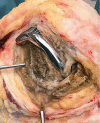Massive osteolysis due to galvanic corrosion after total knee arthroplasty: a rare cause for early revision?
- PMID: 32047588
- PMCID: PMC7006524
- DOI: 10.1093/jscr/rjaa002
Massive osteolysis due to galvanic corrosion after total knee arthroplasty: a rare cause for early revision?
Abstract
A 66-year-old male underwent a total knee arthroplasty for osteoarthritis after previous anterior cruciate ligament (ACL) reconstruction. Seven years postoperatively, a symptomatic large lytic lesion was present surrounding the tibial stem. A titanium interference screw, which was used prior to fixate the Anterior Cruciate Ligament (ACL) graft, was in direct contact with the tibial component. Galvanic corrosion may have attributed to the development of the lytic lesion. It is advised to remove any metal hardware in the vicinity of joint prosthesis in order to prevent a possible galvanic corrosive reaction.
Published by Oxford University Press and JSCR Publishing Ltd. All rights reserved. © The Author(s) 2020.
Figures





References
-
- Hol PJ, Molster A, Gjerdet NR. Should the galvanic combination of titanium and stainless steel surgical implants be avoided? Injury 2008;39:161–9. - PubMed
-
- Benevenia J, Lee FY, Buechel F, Parsons JR. Pathologic supracondylar fracture due to osteolytic pseudotumor of knee following cementless total knee replacement. J Biomed Mater Res 1998;43:473–7. - PubMed
-
- Kinney MC, Kamath AF. Osteolytic pseudotumor after cemented total knee arthroplasty. Am J Orthop (Belle Mead NJ) 2013;42:512–4. - PubMed
Publication types
LinkOut - more resources
Full Text Sources

